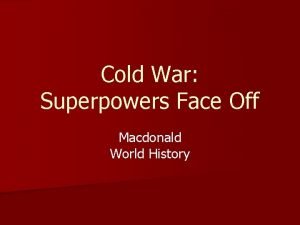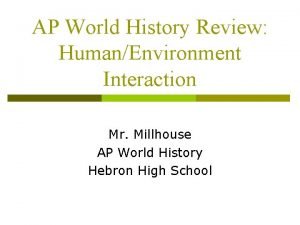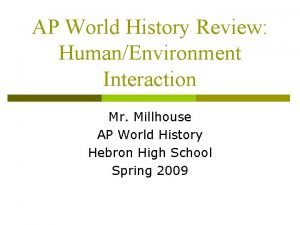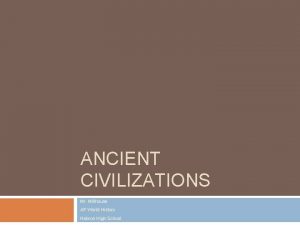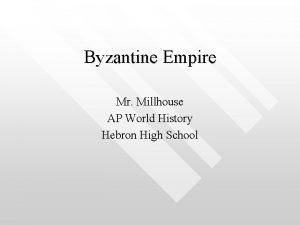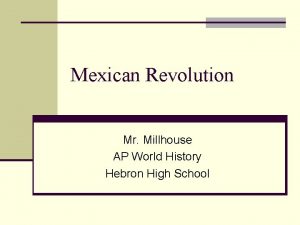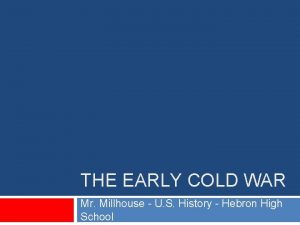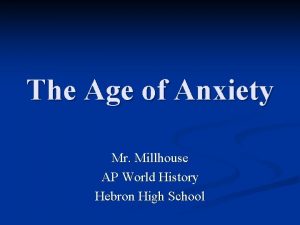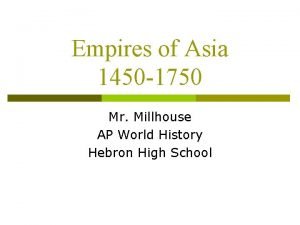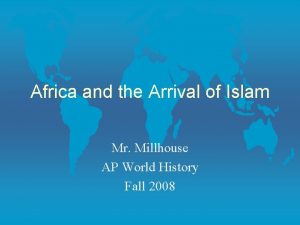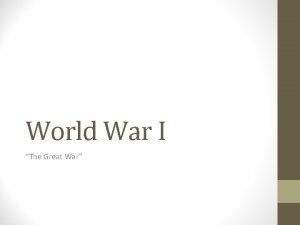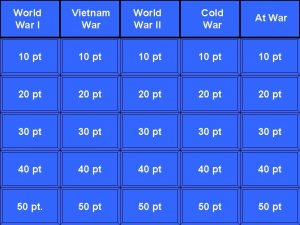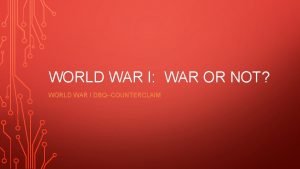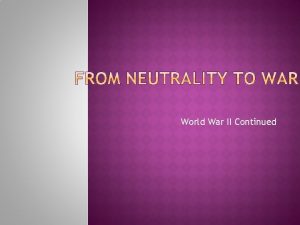World War II Mr Millhouse AP World History



















- Slides: 19

World War II Mr. Millhouse AP World History Spring 2006

Road to War: Asia 1931 -1945 • Japan seizes Manchuria in September 1931 – Japanese government controlled by militarists • Mao’s Long March occurred in 1934 • Japanese invaded mainland China in 1937 – Rape of Nanjing occurred winter of 1937 -1938 – Chaing Kai-shek retreated into western China – Mao’s communist forces led guerilla warfare in East • Japan occupied French Indo-China in 1940

Road to War: Europe 1933 -1939 • Hitler withdraws Germany from the League of Nations in 1933 • Hitler annexes German inhabited regions of Austria and Czechoslovakia in 1938 – Europe follows policy of appeasement at Munich Conference in 1938 • Nazi-Soviet Pact signed August 23, 1939 – Stalin and Hitler agree to divide Poland • Germany invades Poland on Sept. 1, 1939

World War II: European Theater • World War I was a defensive war; World War II was an offensive war – Blitzkrieg led Germany’s easy conquest of Poland, Belgium, France, et al. – Mobilized massive amounts of human and natural resources from around the globe – Citizens viewed as legitimate targets for war • War for oil? – German army attempted to seize Suez Canal – German army besieged Stalingrad

World War II: European Theater

World War II: Pacific Theater • After Japan occupied French Indo-China, the U. S. and Britain stopped shipments of steel, iron, and oil to Japan – Japan bombed Pearl Harbor on Dec. 7, 1941 • Japan quickly conquered Southeast Asia and the Pacific Islands • Battle of Midway marked a turning point – Japan lost 4 of its 6 largest aircraft carriers – Japan’s productivity was one-tenth of U. S.

World War II: Pacific Theater

End of War: European Theater • Three major allied offensives – After victory at Stalingrad, Soviets begin counteroffensive in 1943 – Allies invaded Sicily in July 1943 – Invasion of Normandy (D-Day) June 6, 1944 • Hitler commits suicide on April 28, 1945 • Germany surrendered on May 7, 1945

End of the War: Pacific Theater • U. S. strategy of “island-hopping” bypassed heavily fortified islands to get closer to Japan • Bombing raids of Japan began June 1944 – 40% of Tokyo was destroyed • U. S. dropped atomic bombs on Hiroshima (August 6, 1945) and Nagasaki (August 9) • Japan surrendered August 14, 1945

Hiroshima and Nagasaki

Effects of War • 60 million dead – Six to eight times more than World War I – Over half the dead were civilians victims of massacres, famines, and bombs – Russia lost 25 million; China 15 million; Poland 6 million; Germany 4 million • World flooded with refugees – 90 million fled China – Most refugees never returned home

War of Science • New inventions: synthetic rubber, radar, antibiotics • Military advances: airplanes, tanks, weapons, etc. – Nazi V-2 missiles • Atomic bomb

The Holocaust • Nuremburg Laws passed in 1935 • German and Polish Jews eventually moved to ghettos or work camps • Final Solution starts in 1942 – Applied modern industrial methods to the slaughter of human beings • Killed 6 million Jews and millions of Poles, gypsies, homosexuals, physical and mentally handicapped

The Holocaust Warsaw Ghetto Riots Ovens at Auschwitz Prison Labor Liberation of Dachau

Home Front in Europe & Asia • No clear distinction between “front” and “home front” • Soviet Union dismantled 1500 factories and rebuilt them in Ural Mountains • Russian women took over 50% of industrial jobs and 75% of agricultural jobs • German women were encouraged to stay home and have children – Imported 7 million “guest workers”

Home Front in the United States • U. S. economy experienced prolonged boom after 1940 • Women and minorities were recruited for factory jobs – 6 million women enter workforce – 1. 2 million African-Americans migrate north looking for work • Japanese were placed in internment camps

Women in World War II

U. S. Propaganda

U. S. Propaganda
 Millhouse-project exploit
Millhouse-project exploit Total war world history definition
Total war world history definition Ap world history chapter 25 africa and the atlantic world
Ap world history chapter 25 africa and the atlantic world Dangerous world tour history world tour - hockenheimring
Dangerous world tour history world tour - hockenheimring War at home and abroad madison
War at home and abroad madison Description
Description Lesson 1 the cold war begins
Lesson 1 the cold war begins Reconstruction plans venn diagram
Reconstruction plans venn diagram Josette dugas war of 1812
Josette dugas war of 1812 Ich sein
Ich sein Studyjams force and motion
Studyjams force and motion Why was the civil war considered the first modern war
Why was the civil war considered the first modern war Past simple ge
Past simple ge Toward civil war lesson 3 secession and war
Toward civil war lesson 3 secession and war Proxy wars
Proxy wars Chapter 30 the war to end war
Chapter 30 the war to end war Chapter 30 the war to end war
Chapter 30 the war to end war Chicken war texas history
Chicken war texas history History of cold war
History of cold war The federalist era lesson 3
The federalist era lesson 3


















